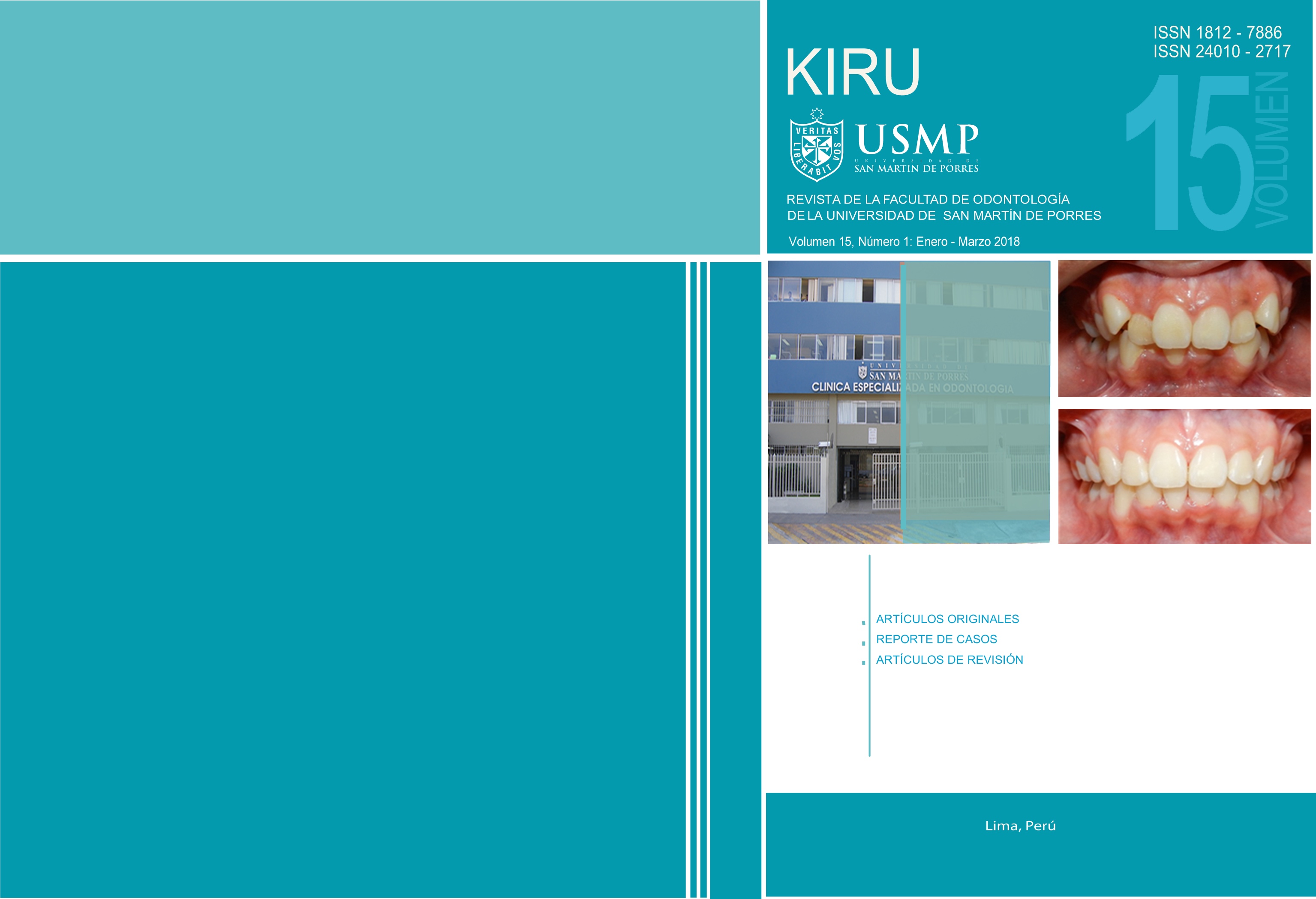Superficial micro-strength of artificial mills of acrylic resin used in rehabilitating dentistry, three trade marks. In-vitro studio
Keywords:
Jaw, Edentulous, Tooth, Artificial, Hardness TestsAbstract
Objectives: The purpose of the present study was to determine and compare the surface microhardness of three brands of artificial molars to verify if there is a significant difference between them. Materials and Methods: artificial molars were used based on acrylic resin, 15 lower molars of each brand TRILUX®, Gnathostar® and Duratone-n®, the samples were prepared making a coronal cross section to obtain a flat, smooth surface and polished, it was placed in pvc dies with 1.5cm Autopolymerizable acrylic, the surface to be analyzed was dyed blue, to then be taken to the Duroline-M Metkon Microdurometer where 3 indentations were made for each sample with a force of 200 grams during 15 seconds obtaining the results in units of Vickers (Hv). Results: The TRILUX® brand molars had higher surface microhardness with an average of 24,306 ± 1.41Hv, followed by the morals Duratone-n® with 22.21 ± 0.72 Hv and finally Gnathostar® with 19.82 ± 0.66 Hv, by statistical tests. He was able to confirm thaDownloads
References
Hechavarria B, Venzant Sucel, Carbonell M, Carbonell C. Salud bucal en la adolescencia. MEDISAN [Internet]. 2013 Ene [citado 2018 Abr 05]; 17(1): 117-125. Disponible en: http://scielo.sld.cu/scielo.php?script=sci_arttext&pid=S1 029-30192013000100015&lng=es.
Freitas AC. El sistema masticatorio y las alteraciones funcionales consecuentes a la perdida dentaria. Acta Odontol Venezolana. 2008; 46(3): 2.
Minaya-Sánchez M, Medina-Solís CE, Casanova- Rosado JF, Casanova-Rosado AJ. Peridida de dientes y variables del estado periodontal asociadas en hombres policias adultos. Gaceta Médica de México. 2010;(4): 264-268.
Lugo Ancona P, Barceló Santana F. Resistencia al desgaste de dientes artificiales. Revista Odontológica Latinoamericana. 2009; 1(1): 2-4.
Kurzer M. Estudio comparativo de dureza en dientes artificiales fabricados con diferentes tipos de resinas acrílicas. Revista EIA. 2006 julio;(6): 122.
Lamas C, Paz J, Paredes G, Angulo G, Cardonoso S. Rehabilitación Integral en Odontologia. Odontol. Sanmarquina. 2012;15(1): 21-34.
Lucas LVM; Gennari FH; Goiato Marcello Cohello; Dos Santos DM; Moreno A; Falcón-Antenucci RM. Estética en prótesis removibles. Revista Cubana de Estomatología. 2010 junio; 47(2): 224-233.
El desafío de las enfermedades bucodentales – Una llamada a la acción global. Atlas de Salud. Federación Dental Internacional. 2016; 1(1): 14.
Carr AB, McGivney GP, Brown DT. Prótesis parcial removible. 11a. ed. Madrid: Elsevier; 2006.
Coto S, Martinez A, Rio. JD. Dientes artificiales de composite nanohíbrido: ¿una alternativa a los dientes convencionales? Rev.Gaceta Dental [Internet]. 2011 Septiembre16; [citado 2018 Abr 05]. En: https://www.gacetadental.com/2011/09/dientes- artificiales-de-composite-nanohbrido-una-alternativa-a- los-dientes-convencionales-25577/
Mendoza O. Evaluación de métodos para la medición de dureza en materiales cerámicos y refractarios de ingeniería. 2004 Mayo; 1(1): 16.
Santis A. Análisis de Fallos en Sistemas Aeronáuticos. Madrid: Ed. Paraninfo; 2015.
Narváez A. Microdureza de tres tipos de composite fotopolimerizados por luz halógena y por diodoemisión de luz. Granada: Universidad de Granada; 2007.
IMOCOM. Durómetros-y-microdurómetros [Internet] 2014 [citado 2017 Marzo 14]. Disponible en: http://www.imocom.com/control-de-calidad/ensayos-mecanicos/durometros-y-microdurometros/durometros- y-microdurometros.
Callister W. Ciencia e ingeniería de los materiales 7a. ed. México: Cengage Learning; 2007.
Correa E. Microdureza superficial del esmalte dentario ante el efecto erosivo de tres bebidas gasificadas no alcohólicas. Estudio in vitro. Kiru. 2011; 8(2): 88-96.
Assunção WG, Barbosa ddb, Goiato MC. Evaluation of the wear rates of eight different brands of artificial resin teeth. Cienc Odontol Bras. 2005; 8(4): 6- 12.
Carbone P, Ricciardi A, Macedo A, Chiarello de Mattos M, Silveira R, Faria R. Abrasion wear resistance of different artificial teeth opposed to metal and composite antagonists. Journal of Applied Oral Science. 2009; 17(5): 2-6.
Downloads
Published
Issue
Section
License
- Los autores/as conservarán sus derechos de autor y garantizarán a la revista el derecho de primera publicación de su obra, el cuál estará simultáneamente sujeto a la Licencia de reconocimiento de Creative Commons que permite a terceros compartir la obra siempre que se indique su autor y su primera publicación esta revista.
- Los autores/as podrán adoptar otros acuerdos de licencia no exclusiva de distribución de la versión de la obra publicada (p. ej.: depositarla en un archivo telemático institucional o publicarla en un volumen monográfico) siempre que se indique la publicación inicial en esta revista.
- Se permite y recomienda a los autores/as difundir su obra a través de Internet (p. ej.: en archivos telemáticos institucionales o en su página web) posterior al proceso de aprobación del manuscrito, lo cual puede producir intercambios interesantes y aumentar las citas de la obra publicada.







